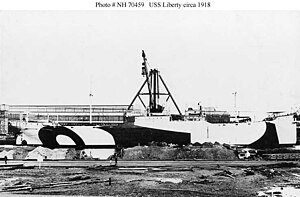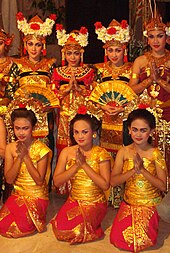Bonaire's capital is Kralendijk. The island has a permanent population of 17,408 and an area of 294 km² (together with nearby uninhabited Klein Bonaire).
The name Bonaire is thought to have originally come from the Caquetio word 'Bonay'. The early Spanish and Dutch modified its spelling to Bojnaj and also Bonaire, which means "Good Air".
Bonaire was part of the Netherlands Antilles until the country's dissolution on 10 October 2010,[6] when the island became a special municipality within the country of the Netherlands.[7] It is now considered the Caribbean Netherlands, or BES Islands comprising three special municipalities located in the Caribbean: the islands of Bonaire, Sint Eustatius, and Saba.[7][8]
| Bonaire Boneiru (Papiamento) |
|||
|---|---|---|---|
| Public body of the Netherlands | |||
 |
|||
|
|||
| Anthem: "Tera di Solo y suave biento" | |||
 |
|||
| Coordinates: 12°9′N 68°16′W | |||
| Country | Netherlands | ||
| Incorporated into the Netherlands | 10 October 2010 (dissolution of the Netherlands Antilles) | ||
| Capital (and largest city) |
Kralendijk | ||
| Government (see Politics of the Netherlands) | |||
| • Lt. Governor | Edison Rijna [1] | ||
| Area | |||
| • Total | 294 km2 (114 sq mi) | ||
| Population (2013[2]) | |||
| • Total | 17,408 | ||
| • Density | 59/km2 (150/sq mi) | ||
| Languages | |||
| • Official | Dutch | ||
| • Recognised regional | Papiamentu[3] | ||
| Time zone | AST (UTC−4) | ||
| Calling code | +599-7 | ||
| ISO 3166 code | BQ-BO, NL-BQ1 | ||
| Currency | US dollar (USD) |
||
| Internet TLD | |||

History
Original inhabitants
European arrival
In 1499, Alonso de Ojeda arrived in Curaçao and a neighbouring island that was almost certainly Bonaire. Ojeda was accompanied by Amerigo Vespucci and Juan de la Cosa. De La Cosa's Mappa Mundi of 1500 shows Bonaire and calls it Isla do Palo Brasil or "Island of Brazilwood." The Spanish conquerors decided that the three ABC Islands were useless, and in 1515 the natives were forcibly deported to work as slaves in the copper mines of Santo Domingo on the island of Hispaniola.[9]Spanish period
In 1526, Juan de Ampies was appointed Spanish commander of the ABC Islands. He brought back some of the original Caquetio Indian inhabitants to Bonaire and Curaçao. Ampies also imported domesticated animals from Spain, including cows, donkeys, goats, horses, pigs, and sheep. The Spaniards thought that Bonaire could be used as a cattle plantation worked by natives. The cattle were raised for hides rather than meat. The Spanish inhabitants lived mostly in the inland town of Rincon which was safe from pirate attack.[9]Dutch period
The Dutch West India Company
was founded in 1621. Starting in 1623, ships of the West India Company
called at Bonaire to obtain meat, water, and wood. The Dutch also
abandoned some Spanish and Portuguese prisoners there, and these people
founded the town of Antriol which is a contraction of "al interior" or
"inside."
The Dutch and the Spanish fought from 1568 to 1648 in what is
now known as the Eighty Years War.
In 1633, the Dutch, having lost the island of St. Maarten to the
Spanish, retaliated by attacking Curaçao, Bonaire, and Aruba. Bonaire
was conquered in March 1636. The Dutch built Fort Oranje in 1639.[10]

British period
During the Napoleonic Wars, the Netherlands lost control of Bonaire twice, once from 1800 to 1803[citation needed] and again from 1807 to 1816.[11] During these intervals, the British had control of the neighboring island of Curaçao and of Bonaire. The ABC islands were returned to the Netherlands under the Anglo-Dutch Treaty of 1814. During the period of British rule, a large number of white traders settled on Bonaire, and they built the settlement of Playa (Kralendijk) in 1810.Emancipation
From 1816 until 1868, Bonaire remained a government plantation. In 1825, there were about 300 government-owned slaves on the island. Gradually many of the slaves were freed, and became freemen with an obligation to render some services to the government. The remaining slaves were freed on 30 September 1862 under the Emancipation Regulation. A total of 607 government slaves and 151 private slaves were freed at that time.[9]
Allotment
World War II
During the German occupation of the Netherlands during World War II, Bonaire was a protectorate of Britain and the United States. The American army built the Flamingo Airport as an air force base. After Germany invaded the Netherlands on 10 May 1940, many Dutch and German citizens were interned in a camp on Bonaire for the duration of war.[12][13] In 1944, Princess Juliana of the Netherlands and Eleanor Roosevelt visited the troops on Bonaire.[9]Post-war
After the war, the economy of Bonaire continued to develop. The airport was converted to civilian use and the former internment camp was converted to become the first hotel on Bonaire.[14] The Dutch Schunck family built a clothing factory known as Schunck's Kledingindustrie Bonaire.In 1964, Trans World Radio began broadcasting from Bonaire. Radio Netherlands Worldwide built two short wave transmitters on Bonaire in 1969.
The second major hotel (Bonaire Beach Hotel)[15] was completed in 1962. Salt production resumed in 1966 when the salt pans were expanded and modernized by the Antilles International Salt Company, a subsidiary of the International Salt Company.[16]
The Bonaire Petroleum Corporation (BOPEC) oil terminal was opened in 1975 for trans-shipping oil.[17]
Economy
Bonaire's economy is mainly based on tourism. The island caters mainly to scuba divers and snorkelers, as there are few sandy beaches, while the surrounding reefs are easily accessible from the shore.
Bonaire is world renowned for its excellent scuba diving and is consistently rated among the best diving locations in the world. Bonaire's license plates carry the logo Divers Paradise (in English).
Bonaire is also consistently recognized as one of the best destinations for snorkeling. Wind surfers also make a strong group of island tourists, as the east side of the island (facing the Caribbean Sea) has the large waves and wind gusts needed for windsurfing.
Lac Bay, in the south east, is shallow, yet windy, and hence is considered an excellent place for intermediate sailors to improve their skills. Tourism infrastructure in Bonaire is contemporary and based on time-share resorts. There are a few small bed and breakfasts. Most resorts have an on-site dive shop. The rest are affiliated with a dive operation.
Ecology
The island is fringed by coral reefs which are accessible from the shore along the lee side of the island facing west southwest. The entire Bonaire coastline was designated a marine sanctuary in an effort to preserve and protect the delicate coral reefs and marine life dependent on those reefs. Montastraea annularis was the most common coral during a recent 2011 survey.[29]The coral reef around uninhabited Klein Bonaire is particularly well preserved, and it draws divers, snorkelers, and boaters. Bonaire also has several coral reefs where seahorses can be found.

Flamingos are drawn to the brackish water, which harbors the shrimp upon which they feed.
Bonaire is also famed for its flamingo populations and its donkey sanctuary.

Starting in the 16th century, the Dutch raised sheep, goats, pigs, horses and donkeys on Bonaire, and the descendants of the goats and donkeys roam the island today, with a small population of pigs roaming as well. Bonaire is also home to the ecologically vulnerable Yellow-shouldered Amazon.
The island of Bonaire has always been at the forefront of nature preservation and conservation and was ecologically responsible long before the mainstream efforts found today.
With the Bonaire Marine Park and the protective status of the Washington Slagbaai National Park, it was only logical to further explore optimal ways to deal with waste and recycled products.
Green Initiatives
Due to a public-private sector partnership, programs are being developed to advance the local awareness and attitudes toward conservation and habitat preservation in order to proactively protect Bonaire's ecosystem.A new sewage treatment plant will contribute to protecting the reefs and the seawater quality. In March 2013 Selibon NV, the national garbage-processing plant, opened an environmental court where the general public can bring glass, cans, paper, scrap metal, cardboard, batteries, motor oil, cooking oil, electronics, mobile phones and textiles.
BonRecycling BV is committed to recycling waste products in Bonaire and to create awareness among the people of Bonaire about the importance and benefits of recycling. Dive Friends Bonaire started a Debris Free Bonaire program that emphasises collecting debris washed ashore and delivering it to the dive shop for separation in preparation for handling by BonRecyling.
Source: Wikipedia.org
Somebody Come and Play in Traffic with Me! Earn as You Learn, Grow as You Go!
The Man Inside the Man
from
Sinbad the Sailor Man
A
JMK's Production
Share this page, If you liked It Pass it on, If you loved It Follow Me!
TTFN
CYA Later Taters!
Thanks for watching.
Donnie/ Sinbad the Sailor Man
Somebody Come and Play in "Traffic" with me. If you would like to "Join" A Growing Biz Op! Here is Your Chance to get in an Earn While You Learn to Do "The Thing" with us all here at Traffic Authority.
Simply click this link and Grow as you Go Come and Play In Traffic With Me and My Team at Traffic Authority!
Simply click this link and Grow as you Go Come and Play In Traffic With Me and My Team at Traffic Authority!
P.S. Everybody Needs Traffic! Get Top Tier North American Traffic Here!














